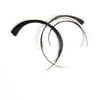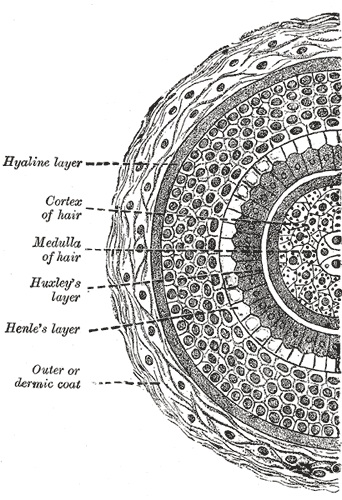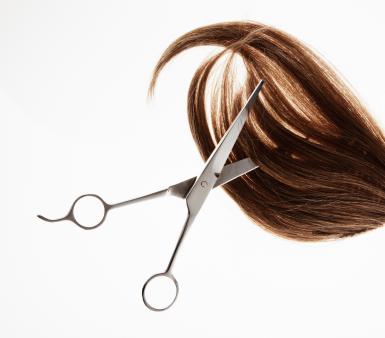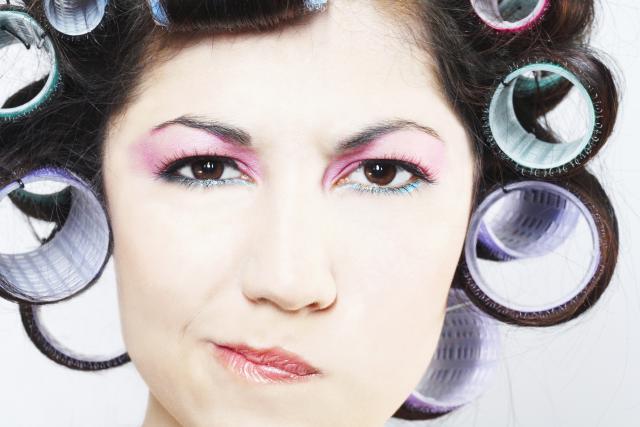|
8/31/2016 Why Is Your Hair Not Growing?Break These Bad Habits ASAP
By Del Sandeen Does it seem as if your hair isn't growing? Well, most likely, it is (if it truly isn't, there may be an underlying health reason, in which case you should consult a doctor). But if your hair breaks off at an equal or higher rate than it grows, you'll never see any length gains. Hair may show stagnant or negative growth rates for a number of reasons. Do any of these sound familiar to you? Because if they do, it's imperative to break these bad hair habits and begin promoting healthy practices that allow you to keep every inch of growth possible. 1. Chemical Overprocessing Overlapping relaxers, aggressive bleaching and applying too many chemicals to tresses are all prime culprits in damage to black hair (all hair types, actually). Damaged hair will still grow from the scalp, but it often breaks off at the ends or requires a drastic cut to get rid of unhealthy sections. Ask yourself if you:
If you answered yes to any of these, it's possible that your hair is overprocessed. Although stylists aren't always foolproof, it's usually better to receive chemical services in a salon at the hands of a capable professional. 2. Trimming Too Often You can have too much of a good thing, and trims fall into this category if you want longer hair. Many women resort to trimming their own hair at home after suffering the results of a scissor-happy stylist. Healthy hair doesn't require as many trims as unhealthy tresses; the less you do to your hair, the less likely you'll need frequent trims that take off an inch or more. Hair grows an average of 1/4 to 1/2 inch per month, so if you care for your hair properly, you don't need to cut more than 1/2 inch every few months or so if you want to see growth. 3. Lack of Conditioning Dry, brittle hair can happen to anyone if she's not diligent about conditioning. Black hair (basically curly hair) often craves moisture, even natural locks. If you're not currently:
you may need to start. It's very difficult to over-condition black hair (or curly hair), so the more moisturizing products and practices you use, the better conditioned -- and less likely to break -- your tresses will be. 4. Poor Protein Structure Along with a good moisture level, hair needs a suitable protein balance to remain strong. The more chemicals or harsh practices that your mane goes through, the more important protein becomes, simply because every relaxer/touch-up, color and even flat iron press compromises the strength of your strands' cuticles. Weak hair usually breaks, after becoming thinner and less elastic over time. Because hair is comprised of protein, it needs protein in some form or other. As long as you follow a healthy regimen, you won't need as much protein as someone who doesn't, but a little protein helps most women maintain strong tresses. 5. Traction Alopecia Tight styles, particularly ones that pull at the hairline, can do serious damage; in some cases, this damage is permanent, killing follicles forever. If your hairline is sparse, this condition may unfortunately be irreversible. Braids that are too tight, ponytails that pull, suffocating weaves and more are all styles that need to be abandoned. In many cases, a mindset is what needs to change at the same time the style changes. Sleek, straight hair that's pulled within an inch of its life may look good, but healthy hair is about so much more than appearance. It may be time to reexamine your usual hairdos if you realize they're often too tight for your own good. Step-by-step directions and a few awesome tips
By Julyne Derrick I feel like I've seen an inordinate amount of celebrities on TV with their hair wound up in Velcro rollers. They are usually sitting in a chair on their cell phones while someone valiantly attempts to do their makeup. So what's the big deal with Velcro rollers? Why would one use them? Rollers are the secret to adding volume and body to hair, especially around the crown area. "Many hairstylists set their clients' hair in curlers no matter what style they're going for, from updos to long waves," says says pro stylist Garren in InStyle magazine. "They give the hair a lush fullness you can't get otherwise." You can use those old-fashioned hot rollers you probably have stored away in the back of your bathroom closet, but Velcro rollers are the hot tools of choice. And the bigger the size of the roller, the better, otherwise you can end up with curls, when what you are really going after is body. You don't need long hair to use rollers. Because Velcro rollers come in all sizes, you can use smaller ones for shorter hair. To ensure a strong set, spritz hairspray or a setting spray to sections of hair before wrapping them around a roller. And rollers work best on hair that's been blow-dried. Any moisture in your hair and it won't keep a curl. The best thing is you don't have to roll your entire head to get the desired effect. For optimal volume for little effort, simply roll the top section of hair. You can also just roll your bangs if you choose, or even your entire head. Step-by-Step DirectionsHere's how to properly use Velcro or hot rollers to give your hair more body:
How to Use Hot Rollers to Give Hair VolumeIf you are using hot rollers, it's best to use ones with a metal core. The heat transmits much more effectively. Hot rollers can make hair too curly. To combat this, try leaving out the ends of your hair, says stylist Eva Scrivo in her book Eva Scrivo on Beauty. To do this, position the roller 1 to 2 inches from the end of your hair and roll toward the head, leaving the ends out. Scrivo recommends palming a dab of pomade or wax through hair to give it that "sexy, slept-in look." 8/23/2016 0 Comments Why Humidity Makes Your Hair CurlHumid air causes hydrogen bonds to form between water molecules and the proteins in your hair, triggering curls and frizz By Joseph Stromberg - smithsonian.com If you have long hair, you probably don’t need to look up a weather report to get an idea of how much humidity’s in the air: You can simply grab a fistful of hair and see how it feels. Human hair is extremely sensitive to humidity—so much that some hygrometers (devices that indicate humidity) use a hair as the measuring mechanism, because it changes in length based on the amount of moisture in the air. Straight hair goes wavy. If you have curly hair, humidity turns it frizzy or even curlier. Taming the frizz has become a mega industry, with different hair smoothing serums promising to “transform” and nourish hair “without weighing hair down.” But just why does humidity have this strange effect on human hair? Hair’s chemical structure, it turns out, makes it unusually susceptible to changes in the amount of hydrogen present in the air, which is directly linked to humidity. Most of a hair’s bulk is made up of bundles of long keratin proteins, represented as the middle layer of black dots tightly packed together in the cross-section below. Bundles of keratin proteins (the middle layer of black dots above) are susceptible to changing shape on a humid day. Image from Gray’s Anatomy
These keratin proteins can be chemically bonded together in two different ways. Molecules on neighboring keratin strands can form a disulfide bond, in which two sulfur atoms are covalently bonded together. This type of bond is permanent—it’s responsible for the hair’s strength—and isn’t affected by the level of humidity in the air. But the other type of connection that can form between adjacent keratin proteins, a hydrogen bond, is much weaker and temporary, with hydrogen bonds breaking and new ones forming each time your hair gets wet and dries again. (This is the reason why, if your hair dries in one shape, it tends to remain in roughly that same shape over time.) Hydrogen bonds occur when molecules on neighboring keratin strands each form a weak attraction with the same water molecule, thereby indirectly bonding the two keratin proteins together. Because humid air has much higher numbers of water molecules than dry air, a given strand of hair can form much higher numbers of hydrogen bonds on a humid day. When many such bonds are formed between the keratin proteins in a strand of hair, it causes the hair to fold back on itself at the molecular level at a greater rate. On the macro level, this means that naturally curly hair as a whole becomes curlier or frizzier due to humidity. As an analogy, imagine the metal coil of a spring. If you straighten and dry your hair, it’ll be like the metal spring, completely straightened out into a rod. But if it’s a humid day, and your hair is prone to curling, water molecules will steadily be absorbed and incorporated into hydrogen bonds, inevitably pulling the metal rod back into a coiled shape. Why Face Shape and Hair Texture Matters Most
By Julyne Derrick In this article, you'll find out what hairstyles work best for thin hair, thick hair and curly hair. You'll figure out how to pick the perfect haircut by face shape and hair texture. Check out my picture down on the bottom of this page. I have a long face and a high forehead (I was once dubbed 'IMAX' by a frat guy in college). In my lifetime, I've had short hair, shoulder-length hair and long hair. Of all the hairstyles I've had, a shoulder-length cut with side-swept bangs looks best on me. It works with my face shape AND my hair texture, which is the key to all great haircuts. Consider Your Face Shape The secret to great haircuts is two-fold: first you must consider your face shape and secondly, you need to choose a cut that works with your hair's texture. Find out what your face shape is. Just as there are flattering styles for all face shapes, there are also unflattering styles. Get the scoop on which cuts work and which ones don't with your face shape in The Best & Worst Styles for Every Face Shape. Not everyone should worry about her face shape, find out if you should in Does Your Face Shape Really Matter? Choose a Cut That Works With Your Hair Texture Each one of us can classify our hair into one or more hair texture types: Dry, coarse, curly, wavy, straight, fine, stringy, limp, oily. If you have thin, stringy hair that tends to fall flat, your hair will look fuller the shorter it is. Coarse, curly girls need to weigh hair down with length: The shorter you go, the higher the frizz and fluff factor. Same thing with bangs. If you have curly, coarse hair, bangs are an invitation to frizziness. Straight hair can fall flat, but cutting in layers adds body. And no matter your hair type, damaged hair never looks good. Cut it off. The Most-Flattering Haircut on Everyone I was struck a couple years ago by a passage in my favorite beauty bible, "Confessions of a Beauty Editor". The writer, Linda Wells, stated that almost everyone at Allure Magazine where she works has shoulder-length hair. Turns out shoulder-length hairstyles are universally the most flattering on nearly everyone. Long hair can make a long face appear longer. Short hair can make a round face appear rounder. Short hair is especially dangerous on super curly hair. If you are petite, you could look like a 15-year-old with super long hair. But shoulder-length hair looks good on all women no matter their size, face shape or age. Who Can, and Can't, Go Long? Long hair generally means below the shoulders. Women who generally shouldn't go long are super-short people (you'll forever look age 12) and women with long, narrow faces (like me, wahhh). Women who look fabulous in long cuts have oval or square faces. That said, anyone with hair below their breasts is taking a risk of looking outdated. There is One Long Cut That's Universally Flattering The 'v-cut' is long in the back and shorter along the sides. This cut works because the length is in the back and not around the face. Lip and chin-grazing layers on the side add to the sexy allure. The Basic Dos and Don'ts For Short Hair Short hair comes in a variety of lengths. In order to figure out which length works for you, consider your best and worst assets and your height. Super short hair on very tall women can look too masculine or it can look very powerful (depending on how you see it). Short hair on women with round faces can make the round face appear fuller, however rules are meant to be broken, as my popular gallery, The Best Short Hairstyles for Round Face Shapes, proves. Typically, you'll want to grow your hair longer than your chin if you have a round face. If you have a pointy chin, avoid hair that falls right at the chin. If you have great eyes, consider short hair with side-swept bangs that hit right at the eye. Remember, a good hair cut masks your downfalls and promotes your best features. Why You Should Consider Upkeep If you're like me and you hate going to the salon or if you tend to put it off for months on end, ask your stylist for a cut that will grow out nicely. Eva Scrivo of Eva Scrivo Salon in NYC told me a great haircut should last 3 months. Uh-Oh, What About That Forehead? Small forehead? Consider bangs that start further back on the head and that are as long as possible Big forehead? Bangs are flattering because they cover up the 'IMAX' screen. Side-sweeping bangs are the most flattering look for you. According to 'Confessions,' bangs are flattering when they are longer at the temples than in the middle. Get the full article with links here By Kendra Aarhus
Hair products are a multi-billion dollar industry in the United States. Flashy advertising and beautiful imagery of perfect hair makes us all long for better hair days. Unfortunately, those commercials are also full of deceit; careful wordsmiths bend the truth to an often unrecognizable state. While the lies in the hair industry are vast, these four in particular need to be addressed and understood by woman everywhere. See if you've believed these four bold faced lies. 1) You Can Not Repair Split Ends Once a hair has split, you can put the most expensive serums and potions on your hair but nothing will repair that split end. Sure there are products that will smooth the frayed ends, and there are products that might even make your split ends appear (temporarily) repaired. Heat from a hair dryer, curling iron, or flat iron can also make split ends appear less frizzy for a while; in reality the high heat is probably making your split ends worse. The truth is, the only thing that will actually repair your split ends is a haircut. Maintaining healthy hair practices, using products that don't dry your hair out, and making sure you get regular trims can prevent split ends. Products that promise to repair split ends are preying on your hopes and dreams. 2) You Can't Penetrate Your Hair with Protein Protein treatments can be a nice treat for your hair and many are healthy for your scalp, but the fact of the matter is that protein products do not penetrate the cuticle of your hair. Products that claim to strengthen your hair with protein from the inside out, simply coat your hair with protein. In fact, over use of protein sprays can often be drying and cause your hair to get brittle or frizzy due to build up on the hair shaft. What about the protein and keratin treatments that promise soft, frizz free hair? Well, that's a whole different chemical and heat reaction that has nothing to do with protein actually penetrating the cuticle of your hair shaft. The best way to strengthen your hair from the inside out, is to take really great care of your scalp and to eat a hair healthy diet. Once your hair has grown past the surface of your scalp, it's at the mercy of the way you treat your hair on a daily basis. Keeping your hair hydrated and healthy will go a lot further than empty protein promises. 3) All Natural Hair Products, Usually Aren't There's a big all natural product push going on in the beauty industry. Cosmetic companies are removing all kinds of harmful chemicals from their products and proclaiming their success on their labels. You've likely started wondering about the sulfates and parabens in your products by now. The biggest problem is that the cosmetic industry by-and-large is very under regulated in the United States, and just because a label makes claims to be all natural, chemical free, or organic, doesn't mean that the formula is meeting any standards to actually live up to it's promises. In all honestly, there are very few "standards" set to begin with, so labeling ends up being a big advertising scheme. The other side of the problem is the internet; full of conflicting advice and doomsday warnings from a lot of people that have no actual education on the subject beyond what they learned by a Google search. It's hard to know what to believe and whom to trust. The only way to truly understand what's in your cosmetics and your hair products is to understand how to read the label. I'll be honest; I'm not a chemist and I don't understand the majority of the labels of the products I use. But, until the cosmetic industry gets it's act together with honest labeling, there's really no way to be completely sure. My biggest advice to anyone that's concerned with the chemicals in their hair products is to do your homework by researching reputable sources to determine what exactly is in your hair care products. Don't blindly trust the label to tell you the truth. 4) Your Hair Products are Full of Wax Some of the products that make your hair feel soft and healthy are actually riddled with wax and silicone. There are a few waxes found in cleansing conditioners, no-poos, conditioners, and styling products that are pretty horrible. Why? Heavy waxes and silicones start off feeling soft and smooth, but over time these feel good additives can build up on your hair. Unlike other product build up problems, a clarifying shampoo isn't usually strong enough to strip silicone build up from your hair. This build up can cause serious damage and breakage to your hair, and long term product buildup can actually clog your hair follicles. Hair follicles that are gunked up with wax can lead to hair thinning, weak hair, and even baldness. Yes. You can go bald from an overdose of wax and silicone build up. The only way to keep the wax off your hair and out of your follicles is to avoid the worse offenders whenever possible. Silicones can be easily identified, as they usually end in -one, -conol, or -xane (such as, Dimethicone, Cetearyl methicone, Dimethiconol, or Cyclopentasiloxane). Waxes to avoid include mineral oil (paraffinum liquidum), petrolatum, bees wax, and candilla wax (to name a few). Fortunately for all of us, there are water soluble silicone based products that are great at helping you get that soft feeling of silicone, but will wash away with water and your favorite shampoo. Water soluble silicones are easily recognized by the "PEG" on the label include ingredients like this:
(source) |
Hair by BrianMy name is Brian and I help people confidently take on the world. CategoriesAll Advice Announcement Awards Balayage Barbering Beach Waves Beauty News Book Now Brazilian Treatment Clients Cool Facts COVID 19 Health COVID 19 Update Curlies EGift Card Films Follically Challenged Gossip Grooming Hair Care Haircolor Haircut Hair Facts Hair History Hair Loss Hair Styling Hair Tips Hair Tools Health Health And Safety Healthy Hair Highlights Holidays Humor Mens Hair Men's Long Hair Newsletter Ombre Policies Procedures Press Release Previous Blog Privacy Policy Product Knowledge Product Reviews Promotions Read Your Labels Recommendations Reviews Scalp Health Science Services Smoothing Treatments Social Media Summer Hair Tips Textured Hair Thinning Hair Travel Tips Trending Wellness Womens Hair Archives
June 2025
|
|
Hey...
Your Mom Called! Book today! |
Sunday: 11am-5pm
Monday: 11am-6pm Tuesday: 10am - 6pm Wednesday: 10am - 6pm Thursday: By Appointment Friday: By Appointment Saturday: By Appointment |







 RSS Feed
RSS Feed